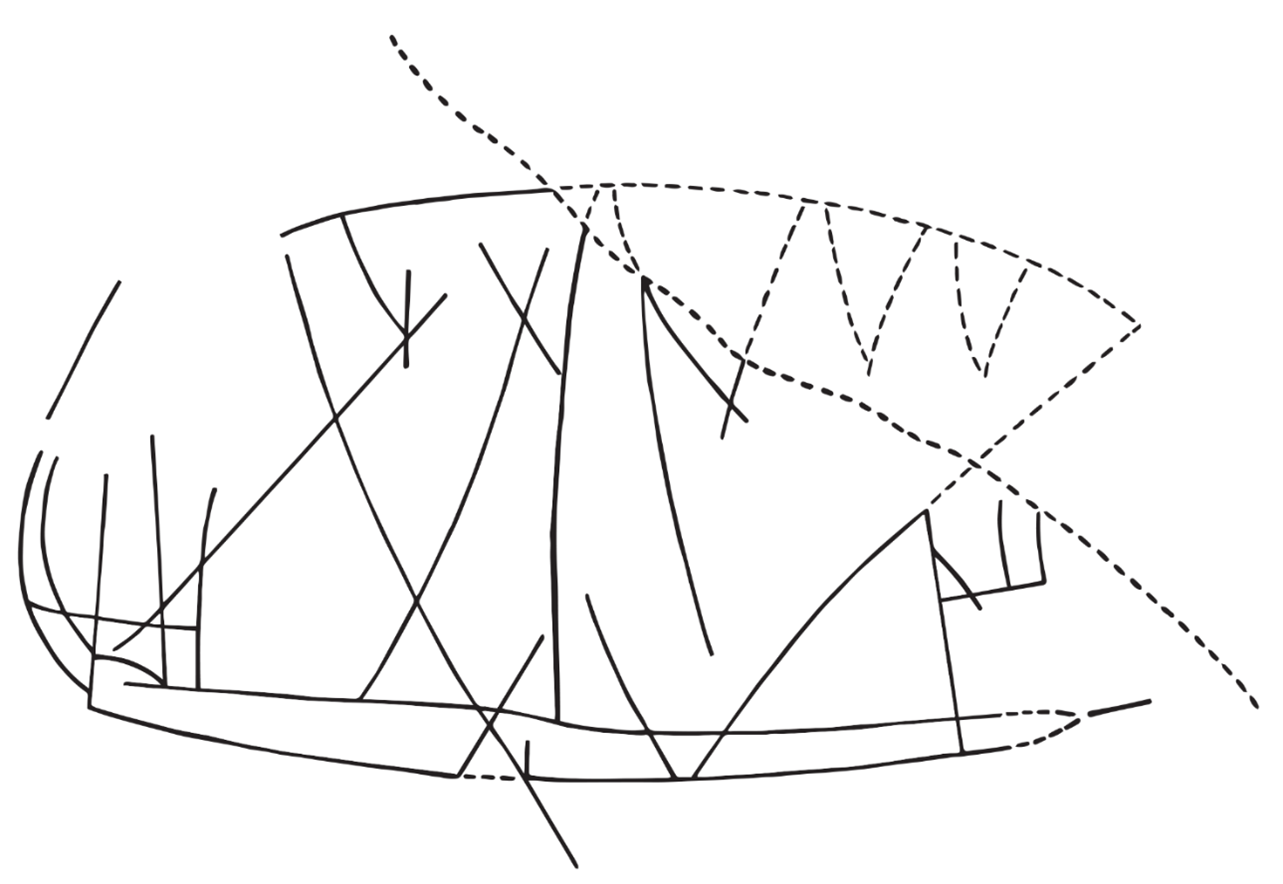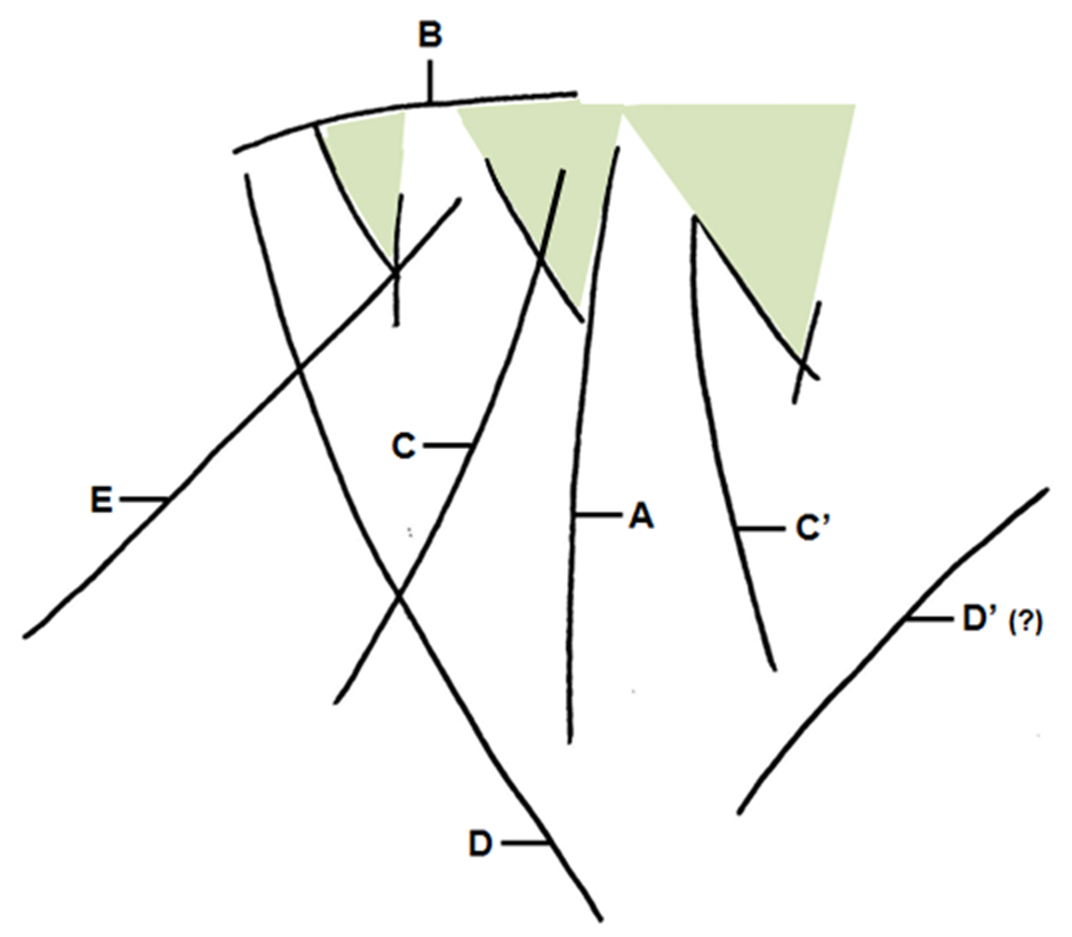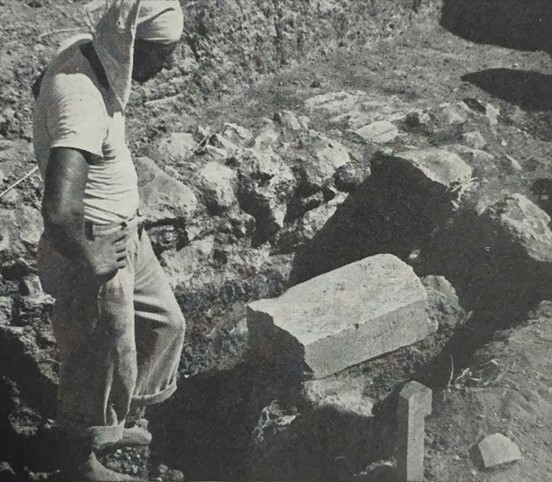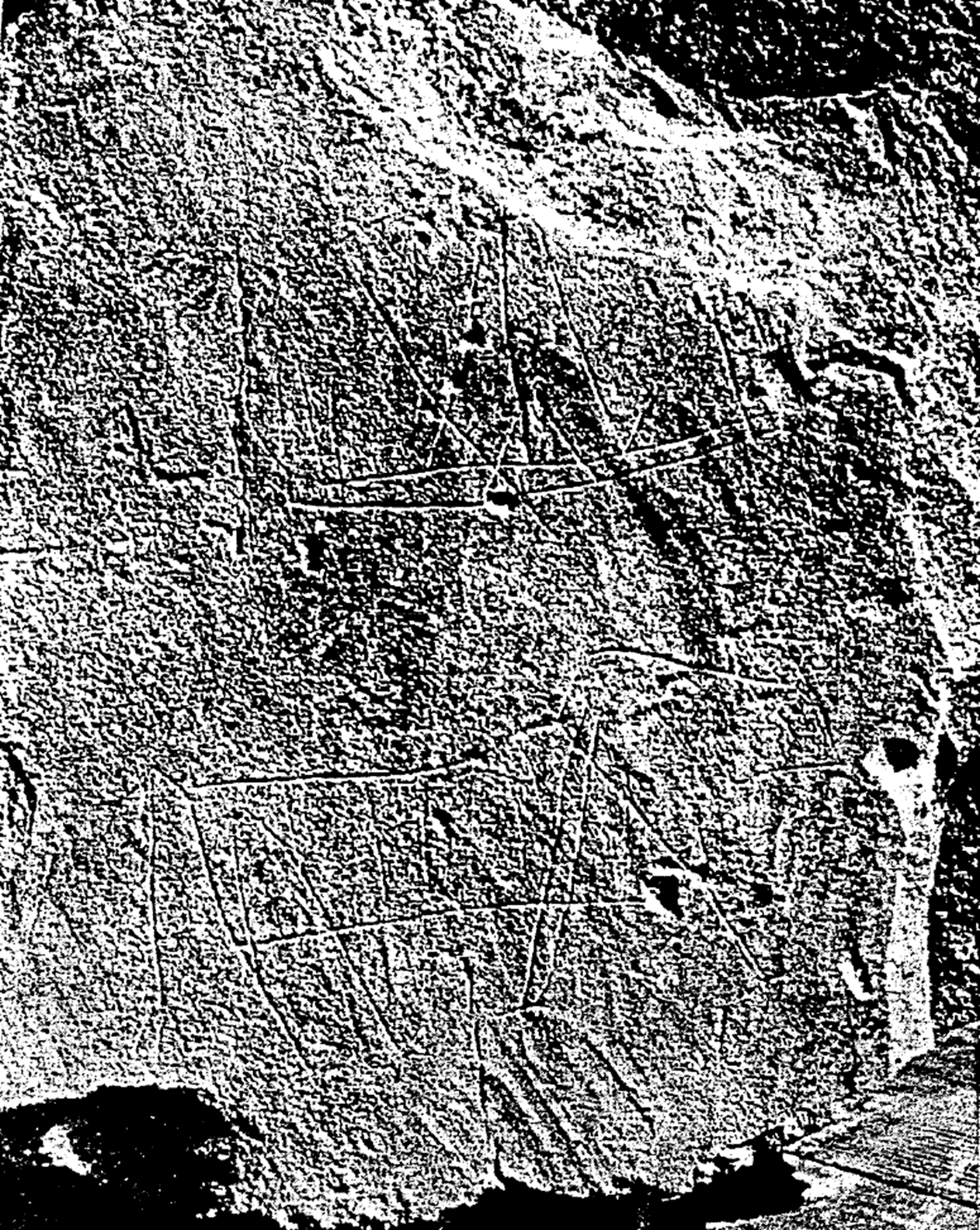Ship to the right with a low flat hull, a straight vertical stempost, and a high curving sternpost. There is damage in the area of the bow projection so that its exact shape is difficult to determine, but it is certainly quite long as it extends well beyond the stempost. Part of the preserved line also indicates that it is a more or less a straight continuation of the keel line and does not curve either upwards or down. Roughly midway up the stempost is a device comprised of a projecting horizontal line attached to the stempost by an oblique line and topped by two perpendicular vertical lines near its extremity. The three vertical lines at the stern, with a horizontal line crossing them near the base of the sternpost probably represents an aftercastle. The mast (A) is amidships, with the yard (B) raised to the top showing a brailed rig with a furled sail. Lines C and C' are either halyards or brails, line D and possibly line D' is a brace, while line E is the backstay. Alternatively, line D' has been interpreted as a forecastle. The triangles shaded in green represent the furled sail. The large triangle at the base of the mast indicates the mast-step system - a massive triangular tabernacle.
Ship graffito
C88
Late Cypriot III (c. 1200 B.C.)
Enkomi
L: 50 cm
Roughly rectangular block of fine grained limestone with two prepared surfaces.
Basch 1987: 147-48, no. 312; Casson 1971: pl. 27; Knapp 2019: 140; Le Bon 1997: figs. 3.7a-b, 3.8, 8.1, 8.2; Schaeffer 1952: 102-104; Vermeule 1964: 259; Wachsmann 1998: 142-44, fig. 7.29a-b; Westerberg 1983: 17, fig. 13
The graffito was found during the excavation of building 18, the most impressive and extensive structure of LC III at Enkomi, which occupied an entire city block and measures 40 m on its main south side. This south façade has four 2 m wide doorways and four windows, and its walls consist of impressive ashlar masonry. By the end of LC III A, building 18 was divided into smaller rooms using rubble walls, and partly served as a copper-smelting facility. Information about the graffiti bearing block's stratigraphical context is scant. Schaeffer notes that the stone was found at a depth of 1.37 m. The rectangular slab of limestone has two prepared surfaces bearing four graffiti in total: a ship and a bull on the stone's broad surface, and a manned chariot and a rectangular structure on its side. The carefully smoothed surfaces and the neatly executed angles of the stone's corners provide a strong indication that it was specifically worked to receive the graffiti. There is also a strong sense of composition in terms of the arrangement of the graffiti, which were all executed in the same style and technique and should therefore be read as a group. The ship and the bull are aligned with one another and are roughly the same size. Basch's later photograph and drawing of the ship graffito clearly indicate that there is a fissure or crack on the upper right side of the composition, with a large area of damage which has erased part of the sail and rigging to the right of the mast.
The original drawing by Schaeffer did not indicate the damage of the upper right corner of the graffito, leading to significant misinterpretation by some scholars such as Casson and Westerberg who interpreted line D as a sail billowing to the left, thus flipping the direction of the ship. As Wachsmann observes, the correct orientation of the vessel is to the right, which is also very clear from Basch's correction to the stempost which is curved rather than straight as wrongly interpreted in Schaeffer's drawing. There are enough indications despite the damage that the rigging was rendered in a symmetrical manner, as suggested by the triangle fore of the mast which continues the furled sail, as well as line C' which mirrors the halyard or brail C. Following this pattern, it is possible that line D' therefore does not represent the forecastle, but rather the second brace. I have indicated the plausible reconstruction of the damaged areas of the graffito in red. It is remarkable that the triangular mast-step system is attested in all three Cypriot pictorial representations of ships of the Cypro Archaic I period. It can be argued that this is therefore a feature peculiar to Cypriot vessels that had already emerged by the 12th century and was preserved during the EIA. Wachsmann brings to attention the fact that the furled sails of the Egyptian and Sea People's ships at Medinet Habu show the central portion of the sail as more loosely furled than at the yardarms. The same appears to be the case here, with the triangles closest to the mast being larger.
Basch, L. 1987. Le musée imaginaire de la marine antique. Athens: Institut Hellénique pour la preservation de la tradition nautique.
Casson, L. 1971. Ships and Seamanship in the Ancient World. Princeton: Princeton University Press.
Knapp, A. B. 2018. Seafaring and Seafarers in the Bronze Age Eastern Mediterranean. Leiden: Sidestone Press.
Le Bon, E. 1997. “Images out of Water: Aspects of the Interpretation of Ancient Maritime Grafitti.” PhD Thesis, University of St. Andrews, UK.
Schaeffer, C.F.A. 1952. Enkomi – Alasia: nouvelles missions en Chypre, 1946-1950. Paris: C. Klincksieck.
Vermeule, E. 1964. Greece in the Bronze Age. Chicago: University of Chicago Press.
Wachsmann, S. 1998. Seagoing Ships & Seamanship in the Bronze Age Levant. College Station, TX: Texas A&M University Press.
Westerberg, K. 1983. Cypriote Ships from the Bronze Age to c. 500 B.C. (SIMA, Pocket-books, 22). Göteborg: P. Åströms förlag.







